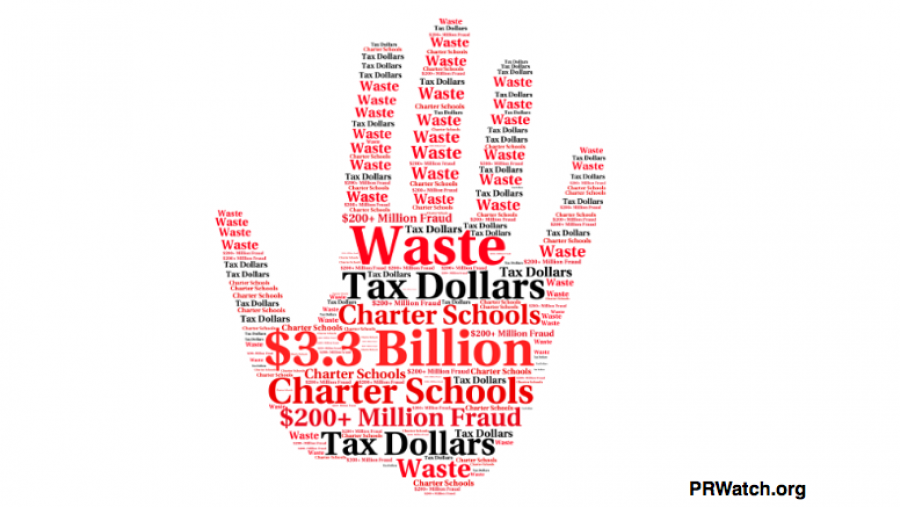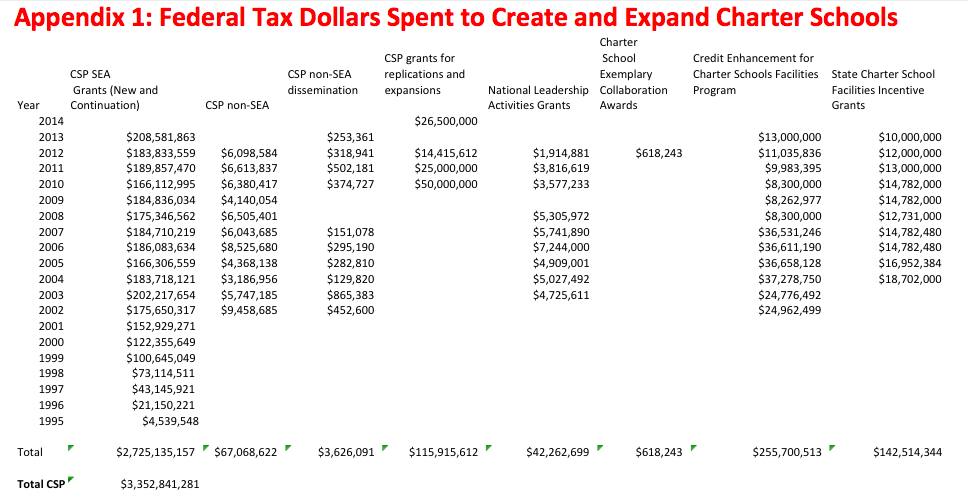Submitted by Jonas Persson on

“The waste of taxpayer money—none of us can feel good about,” Education Secretary Arne Duncan told the Appropriations Subcommittee on Labor, Health & Human Services and Education just last month.
Yet, he is calling for a 48% increase in the U.S. Department of Education’s (ED) quarter-billion-dollar-a-year ($253.2 million) program designed to create, expand, and replicate charter schools—an initiative repeatedly criticized by the Office of the Inspector General (OIG) for suspected waste and inadequate financial controls.
CMD’s review of appropriations reveals that the federal government has spent a staggering sum, $3.3 billion, of taxpayer money creating and expanding the charter school industry over the past two decades, but it has done so without requiring the most basic transparency in who ultimately receives the funds and what those tax dollars are being used for, especially in contrast to the public information about truly public schools.
Even more tellingly, other documents reveal that ED has knowingly awarded charter grant to states with no statutory oversight of charter authorizers and schools as the grant applications are evaluated based on how much "flexibility" from state laws charter schools enjoy.
This lack of oversight, which is a design feature rather than a bug, is a recipe for disaster for far too many American school children, and for taxpayers, when large chunks of the money end up either missing in action or in the corporate coffers of charter school "management organizations" exempt from democratic control.
Federal charter school funding has expanded 60-fold since its inception in 1995, and—despite statements by ED and others of regret regarding enormous amounts squandered by incompetent or greedy charter school operators—very little has been done by the government to require strong financial controls to protect the educational opportunities of kids attending charters and to protect our tax dollars from rip-offs and waste.
1. New Finding: The U.S. Government Has Spent $3.3 Billion on Charters Since 1995
The Center for Media and Democracy, a national non-profit investigative watchdog group, launched a review of how U.S. tax dollars are being spent by the charter school industry, in light of news reports of numerous criminal indictments for fraud of charter school operators.
Especially troubling were the findings of the Center for Popular Democracy’s April 2015 review, showing how criminal misuse in 14 states and Washington D.C. has cost taxpayers at least $203 million—a figure, they conclude, that might be “just the tip of the iceberg.”
That’s a huge sum but there’s a lot more that is unknown about how federal tax dollars are spent by charters.
That’s a huge sum but there’s a lot more that is unknown about how federal tax dollars are spent by charters. 
CMD calculates that in the past twenty years the U.S. has spent $3,352,841,281 specifically for charter school development, with many millions more in grants that have flowed to charters.
How did so much money get spent without more people realizing it? Created as an amendment to the Elementary and Secondary Education Act (ESEA), the Charter Schools Program has seen an almost 60-fold increase in the past twenty years: from $4.5 million awarded in 1995 to $253 million in the last fiscal year. Congress is considering a FY 2016 budget for charters under the ESEA of $375 million, an increase of 48%.
This sweeping expansion, under the banner of bipartisanship, is surprising given the fact that academic studies—independent of charter school advocates and its industry—have consistently found mixed results in terms of charter schools and learning outcomes.
And even the most glowing reports funded by school privatization interests have had to admit that the worst charter schools perform much worse than any traditional public school.
Some charter operators have siphoned funding for their own benefit by locating schools in strip malls and other inappropriate locales, including even letting the school double as a nightclub after hours.
Despite these findings and numerous examples of abject failure of particular charter schools, many policymakers have bought into the PR that charters are a panacea for “reforming” traditional public schools.
Yet, as Professor Diane Ravitch has shown empirically, the notion that public schools are failing is not true. And, anti-regulatory charters that evade public accounting about spending tax dollars are not the solution. Neither is a quarter-million-a-year system of federal grants designed, in part, to reward states that do not hold charter schools and their authorizers accountable.
This is the first instalment in a CMD special report on waste and lack of accountability in the quarter-billion-dollar-a-year federal chart schools program. Click here for part 2, part 3, part 4 and part 5. This serialized version expands on the original report as new findings have come to light.

Comments
Debra replied on Permalink
Charters should not be supported w/Tax Dollars.
CityguyUSA replied on Permalink
Failure of Privatization again!